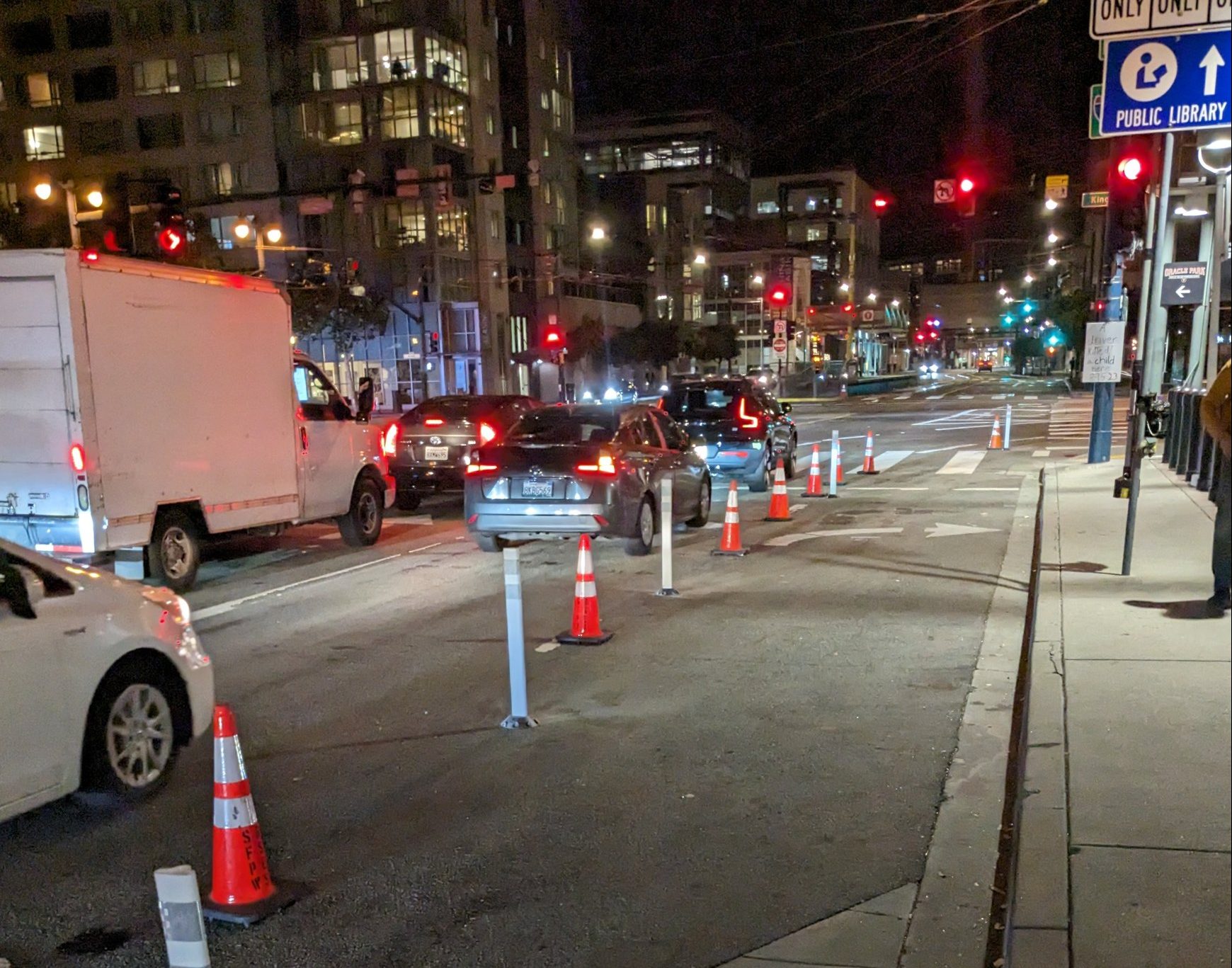Advocates with Safe Street Rebel closed a dangerous turn lane Tuesday night at 4th and King, the location where a small child was run over and killed by a turning driver. KTVU, which was already on the scene covering an earlier vigil, tweeted video of the work:
Community outrage for 4-y/o child killed at SF intersection; rebel group installs barriers
— KTVU (@KTVU) August 23, 2023
A group called Safe Street Rebel has installed a new barrier at 4th & King streets, saying they did not want to wait the 3 weeks the city said it would take to get the job done. @JanaKTVU pic.twitter.com/TZdtkXcLgk
"A week ago, a driver turning right at 4th/King killed a four-year-old. Today at the vigil, SFMTA said it would take three weeks to do a 'quick build' to make the intersection safer. That's too long to wait," wrote an advocate with Safe Street Rebel. "So we did our own quick build tonight and closed one of the turn lanes."
A member of the group explained that the installation was done with tools anyone can buy for a couple of hundred bucks at Home Depot.
And here's video of it in operation during Wednesday evening's rush hour:
Checked out the new @SafeStreetRebel treatment at 4th and King during evening rush hour tonight, vehicles flowed normally, no large queues, why did this ever need to be a double turn lane in the first place? pic.twitter.com/n0thCpuku1
— Kieran Farr (@kfarr) August 24, 2023
"We actually went back there Wednesday/yesterday evening to fix the bolts," Safe Street Rebel told Streetsblog. "They weren't sitting quite right Tuesday night."
At the time this post was published, the guerrilla installation was still there. Typically, SFMTA removes such installations within a few days, even if it means reinstalling more or less the same thing weeks or even years later.
"Our transportation engineering team has been made aware of the posts and will address once their assessment is completed," wrote SFMTA spokesperson Stephen Chun in an email to Streetsblog. He also forwarded bullet points from the mayor's release from Monday, which promised to immediately close the turn lane that Safe Street Rebel has already closed and to add a yellow traffic signal. Streetsblog addressed that weak-sauce release in a post on Tuesday.
So why are unpaid advocates able to get things done so much faster?
It's not that cities can't simply move from spot to spot, all day long, week after week, making streets safe. That's exactly what's going on in Paris and it's why their street transformation is actually happening.

But, of course, that took strong leadership from Mayor Anne Hidalgo, who promised to make a "100% bikeable' Paris," including banning cars completely from many sections (and sometimes from the whole city). Or maybe San Francisco's leaders need to take a page from Hoboken Mayor Ravi Bhalla's playbook; that city has eliminated traffic fatalities over the past four years.

There have been glimmers of such leadership in San Francisco District 6, where the recent tragedy occurred. Former Supervisors Matt Haney and Jane Kim pushed hard for major improvements, including adding parking-protected bike lanes on Howard and Folsom, albeit after horrible tragedies.
That focus seems lost now.
Occasionally crews at SFMTA itself get fed up with the snail's pace of their own leadership and, much like Safe Street Rebel, they take matters into their own hands, as happened at Baker and Fell after a senior was run down and killed by a driver in 2017.
This much is clear: absent Hidalgo-style leadership, San Francisco will continue to fail at its Vision Zero goals, with the city bureaucracy reacting, tepidly and slowly, to one tragedy at a time. Try as they might, unpaid advocates simply don't have the resources to fix the city on their own, especially when SFMTA's response is usually to rip out what they put in. As one such advocate put it, without a significant change in leadership, it's going to take another 4,000 deaths to finish fixing San Francisco's streets.





